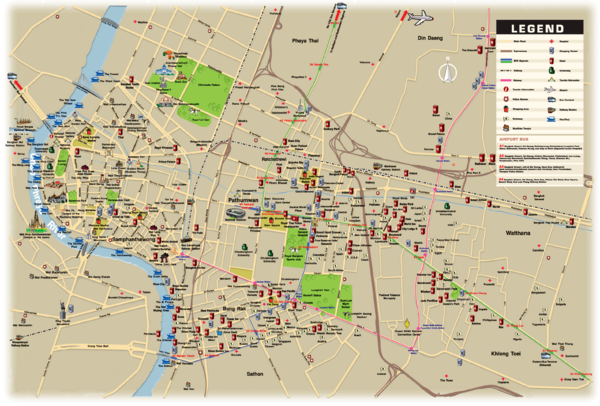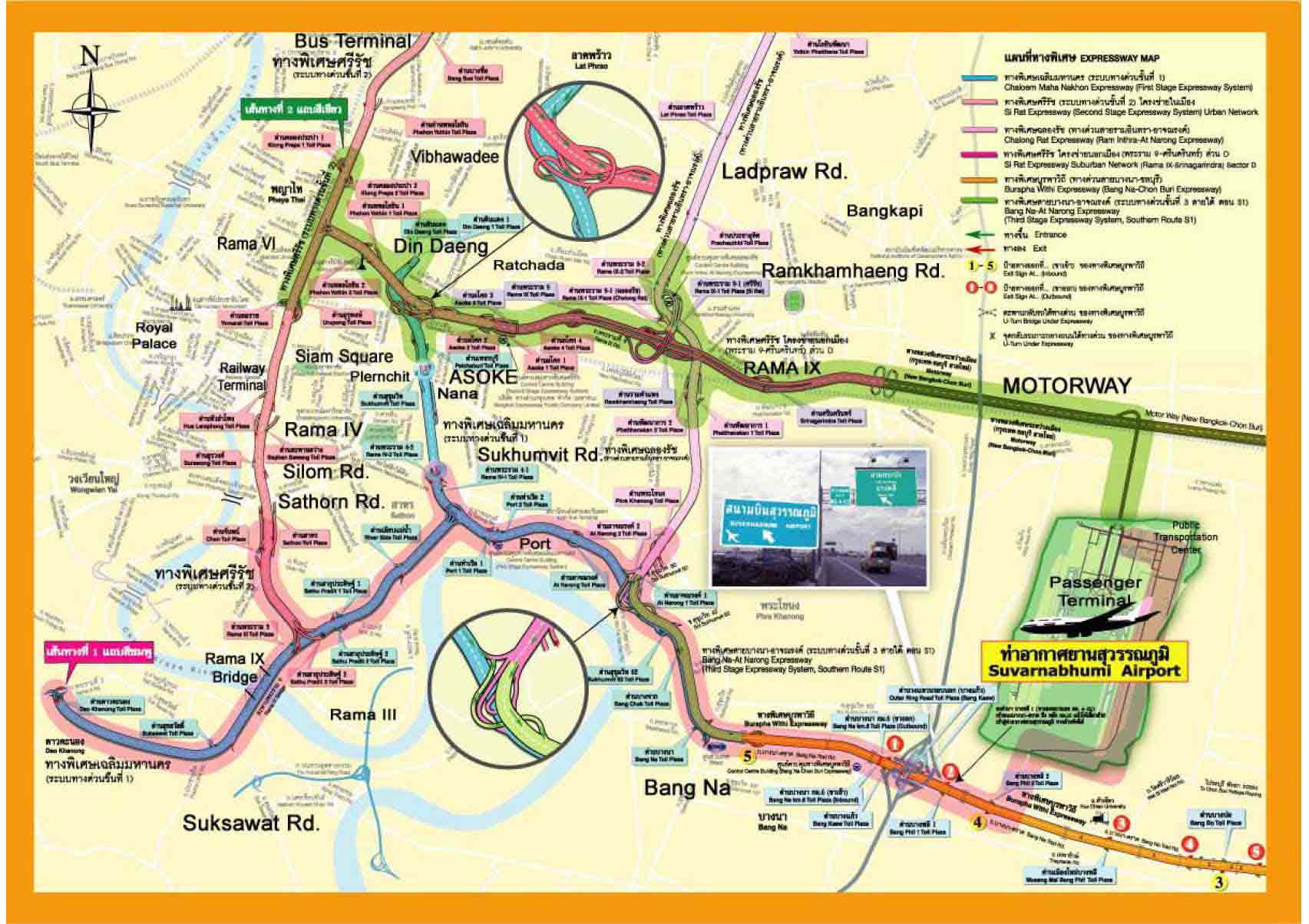Besides the BTS, Bangkok's metro system also comprises the underground railway line MRT, and the elevated Suvarnabhumi Airport Link (SARL), serving several stations in the city before reaching the airport.
The BTS system (the elevated metro system owned by BMA) was initially referred to as the Lavalin Skytrain because it was to be designed using the Vancouver SkyTrain as a model adopting the technology developed by SNC-Lavalin. Due to political interference, the concession with Lavalin was cancelled in 1992, in spite of Bangkok's chronic traffic congestion. The Thai Government focused on increasing road and expressway infrastructure in an attempt to combat congestion. However, this had less than the desired impact as the number of cars on the road increased dramatically. The lines considered under the skytrain project became later the basis for the Bangkok Metro system and interesting enough are mainly underground.
In the early 1990s, foundations for the Lavalin Skytrain were constructed in the middle of two bridges spanning the Chao Phraya river. The Taksin bridge now supports the Silom line to Thon Buri, completed in April 2009. The supports at Phra Pok Klao bridge remain unused but may be utilised as part of the MRT's future Purple Line.
Shortly after it became clear that the Lavalin Skytrain was stalled, then-governor Major-General Chamlong Srimuang asked his deputy Krisda Arunvongse na Ayutthaya to create a new feeder system with a route along Sukhumvit and Silom Rd. Krisda, who in the same period was elected governor, and his team from BMA managed to find an investor to build it. Krisda also convinced all to let the city supervise the project. The investor founded Bangkok Transit System Corporation and this company successfully financed the system and grew it from a feeder system to a full mass transit project. Siemens as supplier of the railway technology and the Thai contractor Italian Thai Development built the system for BTSC.
Originally, the Skytrain depot was to be built underneath Lumphini Park, but due to widespread objections from Bangkok residents it was constructed on a parcel of land located along Phahonyothin Road, replacing the old Northern/Northeastern bus terminal (Mo Chit). The current depot at Mo Chit is a part of the proposed 'Bangkok Terminal' project, where a large complex comprising a new regional bus terminal, park & ride facility and other commercial development can be built directly above it.
Thanayong Public Company Limited (SET: TYONG, Thai: ?????? ????? ????? (?????)) had a 28.21% stake in BTSC when the Skytrain began, and therefore in its early days the system was sometimes referred to as the "Thanayong Skytrain".
The Skytrain system was officially opened on 5 December 1999 by HRH Princess Maha Chakri Sirindhorn. It initially had lower-than-predicted ridership, with 200,000 passenger trips per day. Ticket revenue was only enough to meet the trains' operating cost, and not sufficient to service construction loans. However, the Skytrain's daily passenger numbers have steadily increased since then. On 9 December 2005, more than 500,000 single trips were made on the Skytrain in a single day for the first time. BTSC is currently planning to purchase more trains and is studying the possibility of putting 6-car trains into service. The company implemented a contactless ticketing system in 2007 named 'BTS SmartPass', and plans to allow both BTS and Suvarnabhumi Airport Link passengers to use their RFID smart cards as single ticketing system not before 2014. All of the system's stations are elevated and constructed on three levels. The street level provides access to the station proper via stairs and often escalators. Supporting utility equipment (generators, water tanks, etc.) are usually located at this level on traffic islands. The first elevated level of the stations contains the ticket booths, some small kiosk-like shops and access control gates. The second level (and third at Siam station) is again accessed with stairs and escalators and contains the platforms and rails. With the exception of Siam Station, the stations follow a side platform layout. Siam Station utilizes island platforms to facilitate cross-platform interchange between the two lines. Additionally, many stations have ramps and elevators to allow passengers who use wheelchairs to access the ticketing hall and platforms from the street. The distances between doors are equal throughout the train, regardless of whether they are in the same or different cars, and the locations where the doors will be after the train has stopped are marked on the platform. The platforms are built to accommodate trains of six cars, but trains of only three or four cars are in operation. Security personnel are stationed at every platform and ticketing hall. For safety reasons, there are often signs at the escalators: "Please stand on the right of the escalator and hold the handrail".
The BTS system (the elevated metro system owned by BMA) was initially referred to as the Lavalin Skytrain because it was to be designed using the Vancouver SkyTrain as a model adopting the technology developed by SNC-Lavalin. Due to political interference, the concession with Lavalin was cancelled in 1992, in spite of Bangkok's chronic traffic congestion. The Thai Government focused on increasing road and expressway infrastructure in an attempt to combat congestion. However, this had less than the desired impact as the number of cars on the road increased dramatically. The lines considered under the skytrain project became later the basis for the Bangkok Metro system and interesting enough are mainly underground.
In the early 1990s, foundations for the Lavalin Skytrain were constructed in the middle of two bridges spanning the Chao Phraya river. The Taksin bridge now supports the Silom line to Thon Buri, completed in April 2009. The supports at Phra Pok Klao bridge remain unused but may be utilised as part of the MRT's future Purple Line.
 Bangkok Shopping Map |  Map of Bangkok |  Map of Siam, Bangkok |  Area, Bangkok, Thailand |  Bangkok Shopping Map |
 Visit Bangkok guide : Bangkok |  bangkok visitor map bangkok |  Siam Paragon Shopping Center |  backpacking bangkok |  Shopping Map |
Thanayong Public Company Limited (SET: TYONG, Thai: ?????? ????? ????? (?????)) had a 28.21% stake in BTSC when the Skytrain began, and therefore in its early days the system was sometimes referred to as the "Thanayong Skytrain".
 Fullsize Bangkok Map |  Bangkok Shopping Guide |  A 1971 study of Bangkok |  map |  Check out our guide below. |
 Bangkok Shopping Map |  Bangkok, Nancy Chandler\x26#39;s Map |  Bangkok Shopping Centers (MBK, |  Siam Area Map : Bangkok |  Bangkok Map |
No comments:
Post a Comment